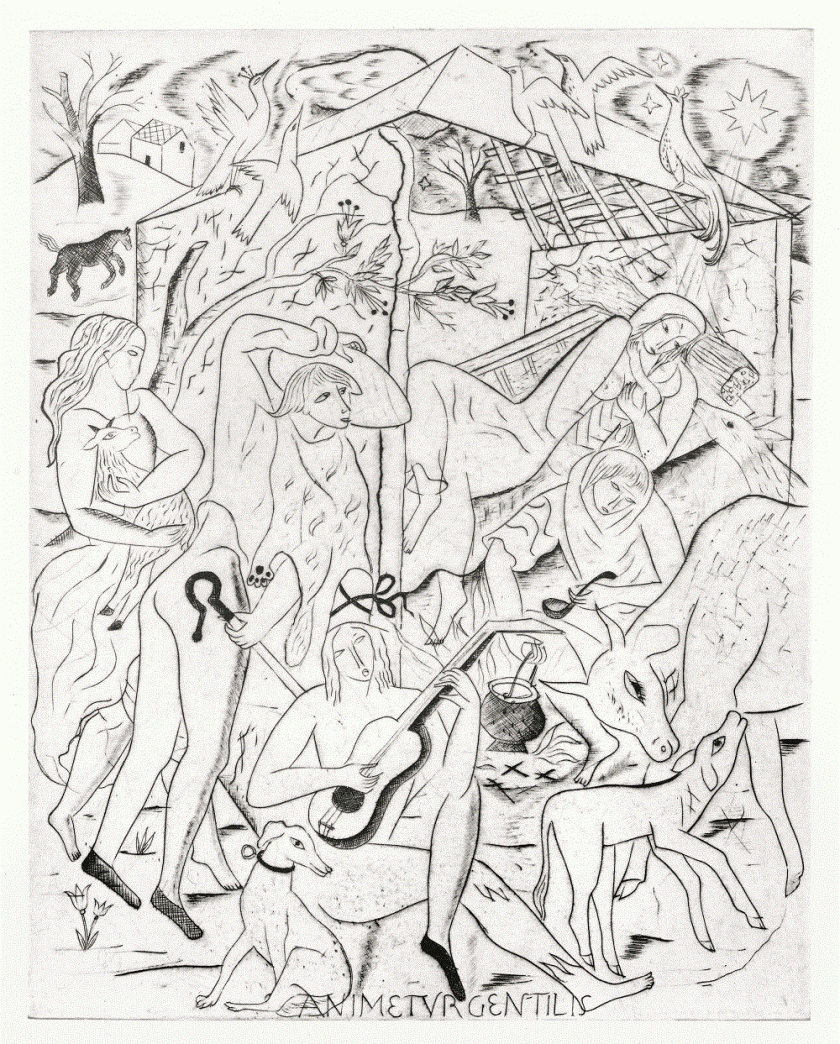David Jones’ black and white drypoint – a drawing made by incising lines on a copper plate with a diamond-tipped needle and then printing from the plate – is a view of the nativity which is fresh, full of wonder and a highly intelligent naïveté. It shows all the sophistication of an artist who has looked at the art of the past but is also fully aware of modernism’s confusions of perspective, able to deploy them even when depicting recognisable scenes.
And this is, of course, the scene that is central to the Christmas story, the sheltering in a humble stable of the most famous refugee family in western history: Mary, Joseph and the newborn baby surrounded by welcoming people and animals. It is typical in that it combines wit, gentle humour and strong emotion in the jumble of tangled and crisscrossing lines which resolve into an intelligible and affecting scene of people and animals, crowding together for comfort and worship.
It's a scene both of hardship and struggle, and of miraculous loveWhat the artist shows us is a totally exceptional moment, but described in a way that is free of pomposity, or grandiosity. It is humble and accepting, and full of a benign curiosity in which all creatures are equal. The cow leans towards her calf, birds fly, a horse gambols in a meadow, a tree stretches skyward, stars shine, there is a pot of soup on the fire, shepherds abide, a baby lamb looks on curiously, and in the midst the Virgin reclines, holding her baby with ineffable tenderness, her pillow a sheaf of corn. It is both a scene of hardship and struggle, set in a ramshackle wooden shed, and a scene of miraculous love, with divine, human, animal and natural world in visible harmony. It is a moment of serene happiness, poised before the difficulties of life resume.
The pattern dances, with Mary and her baby at rest and every other creature animated, from the shepherds to the birds in hovering flight. The Latin inscription, animetur gentilis is a phrase from a canticle for The Feast of the Nativity, indicating that life – perhaps the life everlasting – is being brought to the people.
The poet, writer and artist David Jones (1895-1974) described himself as “a Londoner, of Welsh and English parentage, of Protestant upbringing, of Catholic subscription”. He was a fervent, mystical artist, obsessed by his scrutiny of the world around him, his observations infused and irradiated by his passionate spiritual life. But he was also witty, with a spiritual lightness: his belief was so all-encompassing that he had no need to be bombastic or didactic.
An enigmatic character, traumatised from his experiences of horror in World War One – when he never stopped drawing – and the victim of several breakdowns, his delight in the world and his passionate attachment to the antics of animals never diminished. Although at times he lead a reclusive life – the last 30 years in small bedsits just outside London – he had deep and sustained friendships and had been engaged to Petra Gill, Eric Gill’s daughter. He had belonged to Gill’s communities for several years, and under his tutelage learnt to be a sensitive and original printmaker, outstandingly gifted technically and able to translate his vision into convincing and persuasive scenes, both as illustrations and as stand-alone imagery. Although a master of colour and mixed media – crayon, pencil and watercolour – he worked brilliantly with restricted colour on woodblock or metal plates.
- Nativity with Shepherds and Beasts Rejoicing, on display as part of David Jones: Vision and Memory at Pallant House Gallery, Chichester until 21 February
The Art of David Jones: Vision and Memory by Ariane Bankes and Paul Hills, published by Lund Humphries









![SEX MONEY RACE RELIGION [2016] by Gilbert and George. Installation shot of Gilbert & George 21ST CENTURY PICTURES Hayward Gallery](/sites/default/files/styles/thumbnail_125_x_125_/public/mastimages/Gilbert%20%26%20George_%2021ST%20CENTURY%20PICTURES.%20SEX%20MONEY%20RACE%20RELIGION%20%5B2016%5D.%20Photo_%20Mark%20Blower.%20Courtesy%20of%20the%20Gilbert%20%26%20George%20and%20the%20Hayward%20Gallery._0.jpg?itok=3oW-Y84i)





Add comment